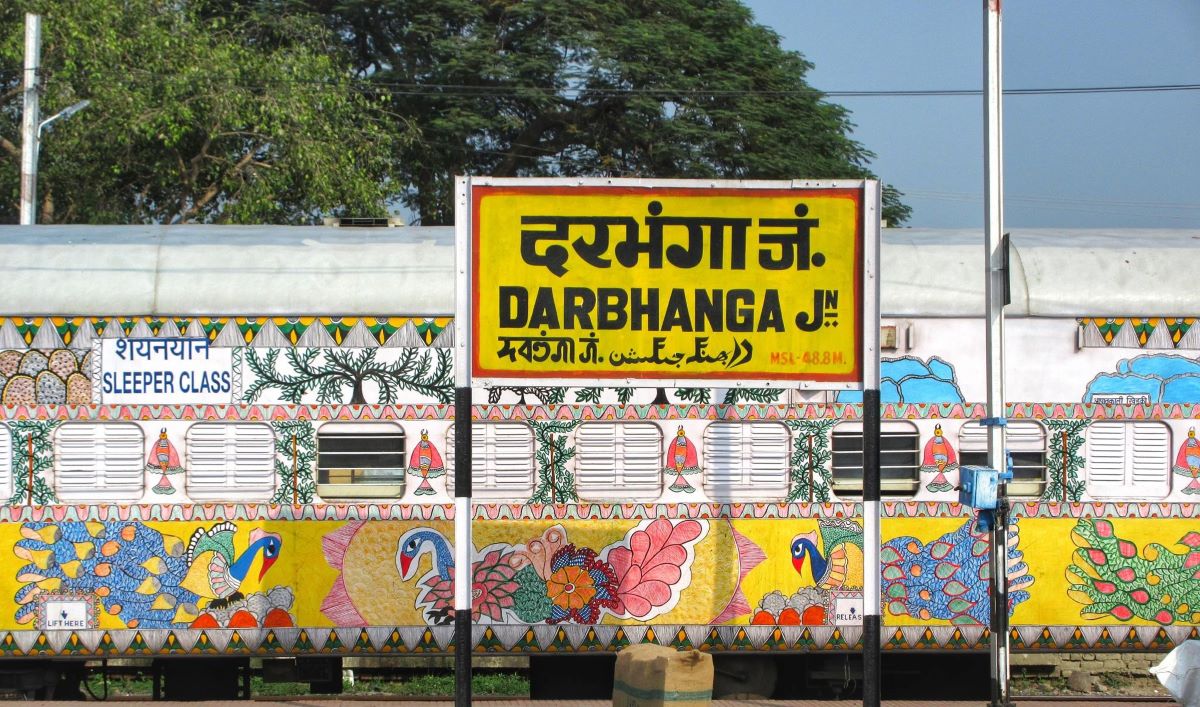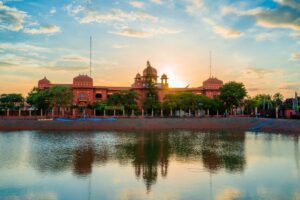There has been a long history of resistance by the Maithili elite to Hindi homogenisation. The resistance continues in many forms.

Darbhanga Jn written in Maithili and other languages at the railway station in the north Bihar city (Facebook/DBGPrideOfECR)
When both the Houses of the Parliament passed the Bill incorporating Maithili language along with Bodo, Santhali, and Dogri into the Eighth Schedule of the Constitution in December 2003, with all parties full-throatedly backing the then deputy prime minister L K Advani’s proposal, it was like Diwali for the activists who had fought for it.
They saw it as the fruit of the struggle their forefathers had begun a hundred years ago, with nerve centres in Kolkata and Allahabad, where they had gone for education and were enlightened. They had asked the British, and they had been asking governments of free India to recognise the distinct identity of the Maithili language, and finally it was Atal Bihari Vajpayee’s government that had granted them the wish.
They would not tire of thanking Vajpayee and Advani. Vajpayee had announced his government would place Maithili in the Eighth Schedule when he came to lay the foundation stone of a railway bridge at Maithili-speaking Nirmali six months ago.
Two months later Advani, visiting Darbhanga, the heartland of Maithili-speaking Bihar to inaugurate a Maithili news bulletin broadcast from the local station of All India Radio, said the PM’s announcement would be implemented soon. “For a change, there is no dichotomy between a politician’s promise and performance,” some Maithili activists said. “Vajpayee has won the hearts of millions of us by fulfilling our dream,” said others.
To be fair to Maithili language activists, they did not ignore the role of the leaders of other parties in pushing for the inclusion of the language in the Eighth Schedule. They remembered the Janata Party government led by Karpoori Thakur had sent a proposal to the Central government recommending it in 1977.
The Congress government led by Jagannath Mishra had also sent a recommendation in 1980. They had gratitude even for the RJD — whose government led by Lalu Prasad Yadav removed it from the list of optional subjects for the state services examinations in 1992 saying it was falling into disuse — for welcoming the inclusion of Maithili in the Eighth Schedule.
However, in the 20 years since Maithili ascended to the galaxy of scheduled languages, the activists have slid from a state of euphoria into a state of melancholia.
Very little has been done for its protection, promotion, or development. It seems like Maithili has been placed in a glass box in a museum of languages, as a glorious and venerable object of the past, without any relation and relevance to the present life.
Hundreds of petitions, memoranda, pamphlets, protests, speeches, representations, and delegations — demanding children whose mother tongue is Maithil be taught in the language in primary schools — have failed to bore any holes into the government’s wall of indifference. This wall is studded with faux gems of warmth.

Lalit Narayan Mithila University, Darbhanga, one of the rare places where Maithili language is taught at the undergraduate, postgraduate, and doctoral levels (iStock)
Neither the Centre nor the state ever says it won’t do it. But the Centre keeps saying education is a concurrent subject and it is for the state to do it, and the state keeps making a promise and not keeping it.
For teaching to start in Maithili in primary schools, there have to be textbooks in the language.
There have to be writers to write those textbooks. There have to be panels of subject experts to oversee the quality of the textbooks. There have to be teachers.
There have to be new schools or additions to existing schools to run classes in Maithili. There has to be more.
For all this, there has to be allocation in the state budget; and there has never been any.
As for the Central budget, Modi’s HRD ministry has not sanctioned even a rupee for it, though its drum-beating ministers constantly remind the world that it was Atal Bihari Vajpayee who made Maithili a scheduled language. But scheduled language for what?
The BJP has been in power for eight years in Delhi. It was in power in Bihar in alliance with the JD(U) for 13 years. Why did it not take steps to develop, protect, and promote the Maithili language?
Why did it stop at admitting it into the Eighth Schedule?
The answer is simple. The BJP wants the number of people reading and writing Hindi to be rising, not falling.
Among the 50-odd languages of North India that Hindi calls its ‘dialects’, only Maithili has graduated into a scheduled language (thanks to Vajpayee’s 2004 electoral compulsions, they say).
The BJP has been strongly resisting the inclusion of other ‘dialects’.
It would not want Maithili to spread, because it will claim a slice of the Hindi space. More and more Maithili speakers will enter their language as Maithili and not as Hindi in the census, reducing the number of Hindi speakers. That might cause a dent in Hindi’s claim as the national language of India.
Worse, if Maithili develops, the other ‘dialects’ of Hindi will follow its example.
The spectre that haunts the BJP is: If all its ‘dialects’ gain autonomy, it will be reduced to be a minority language. As the BJP identifies Hindi with nationalism — one nation, one language — the scenario appears to it like an apocalypse.
Not that the other parties of the North are for the development of the Hindi ‘dialects’.
They might not have as extreme a position as the BJP on Hindi imposition on the south but they are all with it for Hindi imposition on the north.
It is true of both the major ideological streams of the north other than Hindu nationalists — the socialists and the Congress. No wonder, they have been as disinterested as the BJP in developing Maithili.
If truth were to be observed without its clothing, the Constitution of 1949 proclaimed Hindi as the queen and the other languages as her vassals. It made it the duty of the Union to “develop” Hindi as the national language and ‘enrich’ it by “assimilating” the vocabulary, forms, and styles of languages in the Eighth Schedule.
It took 20 years for Parliament to pass an official resolution to create some space even for the vassals to develop.
The resolution of 1968 bound the Centre and the states to take “concerted measures” for the “full development” of the scheduled languages, “so that they grow rapidly in richness and become effective means of communicating modern knowledge”. It also provided for the use of scheduled languages as alternative media in examinations for public services.
However, in total disregard for the resolution, the Centre and the state are doing nothing for the development of Maithili.
Not making it the medium of instruction in primary schools is one instance.
The Maithili Academy is another. The academy, which was set up to preserve, protect and promote the literary and cultural heritage of Maithili, has turned into a ghost house, with no funds, no chairman, no staff, and no publications for years.
Four months ago, the state government announced it would set up two language academies for Surjapuri and Bajjika. The state already had eight language academies — Hindi, Bhojpuri, Maithili, Magahi, Angika, Bangla, Sanskrit, and South Indian languages.
All of them were shells with shrivelled fruits. Why pluck two more shells from your hat and put them in showcases when you have no money for seeds, irrigation, or fertilisers for the plants?
The obvious answer was: for political profit.
Surjapuri, a language that is a blend of Maithili, Bangla, and Hindi, was largely used by Muslims in the Purnia, Katihar, Kishanganj, and Araria districts of eastern Bihar.
There was a now-dormant, now-astir demand for ‘Seemanchal,’ a separate state, from the region.
Bajjika, a language that is a blend of Maithili and Hindi, was spoken mainly in the Vaishali, Muzaffarpur, Sitamarhi, Sheohar, Samastipur, and West Champaran districts of northwestern Bihar.
There had been a demand from the region for recognition of Bajjika as a separate language.
The Bihar state government’s other advantage was that it shrunk the map of ‘Mithilanchal’ — the land of Maithili speakers for which some organisations have been demanding statehood for decades — to its ‘core’ districts of Darbhanga and Madhubani.
The Maithili language activists always included the districts in the map where Angika, Surjapuri, and Bajjika were spoken, because they claimed they were but ‘variants’ of Maithili.
Angika had long before been given an academy. Now even Bajjika and Surjapuri languages were given their own.
People in those districts were now going to clamour for the promotion of Angika, Bajjika, and Surjapuri, not Maithili. Was this for the growth of Maithili or to dwarf it?
The dwarfing continues: Though Maithili remains an optional subject in examinations for the state civil services, the maximum marks from it added to the examinee’s total marks has been reduced to the qualifying marks 30, instead of as much as they got out of 100.
The number of examinees taking Maithili as a subject is naturally falling as a result. Instead of attracting more and more Maithili-speaking youth toward the language, the government is forcing them to desert it.
Is it how Maithili is supposed to “grow rapidly in richness and become effective means of communicating modern knowledge” in accordance with the official resolution of 1968?
Yet, let the Centre and the state be under no delusion that the juggernaut of Hindi homogenisation will succeed in crushing Maithili under its wheels.
There has been a long history of resistance by the Maithili elite to Hindi homogenisation.
The resistance continues in many forms. It is the pride in the great Maithili heritage — the queen of languages and literatures of medieval eastern India — that circulates like blood in the heart, arteries, capillaries, and veins of the resistance movement.
If you think you can kill Maithili by excluding it from schools, offices and education budgets, you are wrong — the Maithili elite is saying to the Centre and the state.
We will keep Maithili alive with funds raised among ourselves. We will publish hundreds of books: novels, short stories, drama, histories, biographies, essays, and travelogues.
We will publish scores of journals in print and online. We will host poetry recitals and stage classical and contemporary plays throughout the year. We will have musical evenings drawing from the rich treasures of our musical tradition and folk songs.
Maithili will ‘grow richly’ in literature, theatre, music and media, the Maithili elite insists, even if it is barred from schools and offices. And who knows a day will come when it will grow so rich the homogenisers will be forced to include it in schools and offices!
(This is the fourth article in a series on the serious challenges Hindi faces from the languages it calls its dialects)
(Arun Sinha is an independent journalist and the author of ‘The Battle for Bihar’. These are the personal views of the author)

Dec 14, 2023

Oct 24, 2023

Sep 14, 2023

Aug 26, 2023

Jun 13, 2023